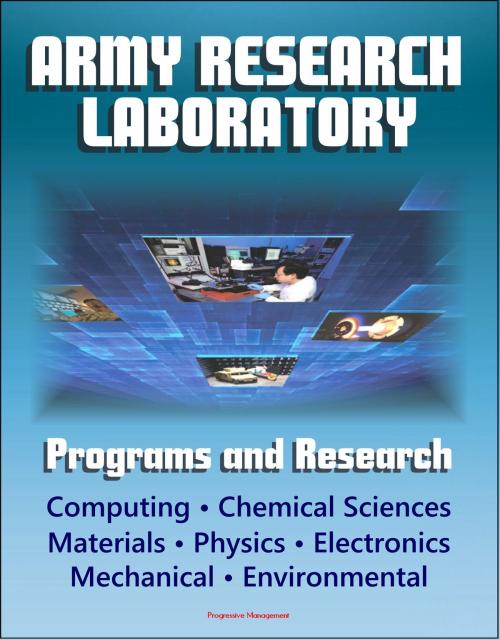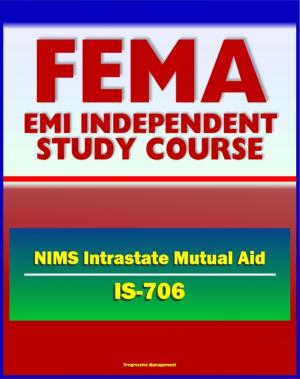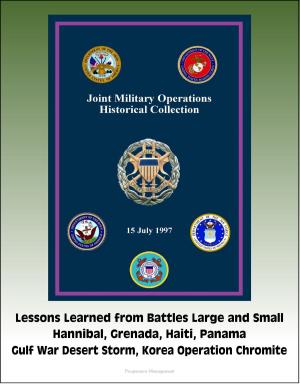Army Research Laboratory (ARL) Programs and Research: Computing, Chemical Sciences, Life Sciences, Materials, Mathematics, Physics, Electronics, Mechanical Science, Environmental Sciences
Nonfiction, Science & Nature, Technology, Military Science| Author: | Progressive Management | ISBN: | 9781476234076 |
| Publisher: | Progressive Management | Publication: | July 12, 2012 |
| Imprint: | Smashwords Edition | Language: | English |
| Author: | Progressive Management |
| ISBN: | 9781476234076 |
| Publisher: | Progressive Management |
| Publication: | July 12, 2012 |
| Imprint: | Smashwords Edition |
| Language: | English |
This single-source document describes the research programs of the U.S. Army Research Office (ARO) of the Army Research Laboratory (ARL). The mission of ARO, as part of the U.S. Army Research Laboratory (ARL), is to execute the Army's extramural basic research program in these disciplines: chemical sciences, computing sciences, electronics, environmental sciences, materials science, mathematical sciences, mechanical sciences, network sciences, life sciences, and physics. The goal of this basic research is to drive scientific discoveries and increase the general store of scientific knowledge through high-risk, high pay-off research opportunities primarily with universities, and also with industrial and governmental laboratories. ARO also ensures that the results of these efforts are made available to the Army research and development community, for the pursuit of long-term technological solutions for the Army.
The Soldiers of today and tomorrow depend on the Army's corporate laboratory to deliver the scientific discoveries, technological advances, and the analyses that provide warfighters with the capabilities with which to execute full-spectrum operations. The U.S. Army Research Laboratory's (ARL) investment portfolio is focused on maturing technologies for transition principally to the Research, Development, and Engineering Centers (RDECs), but also to our other partners in the Army Transformation Program Executive Office/Program Managers (PEOs/PMs), the Army Test and Evaluation Center (ATEC), the Training & Doctrine Command (TRADOC) Battle Labs, the other services, and the private sector.
Chapter 1: ARO Mission and Investment Strategy * Chapter 2: Program Descriptions and Funding Sources * Chapter 3: Chemical Sciences Division * Chapter 4: Computing Sciences Division * Chapter 5: Electronics Division * Chapter 6: Environmental Sciences Division * Chapter 7: Life Sciences Division * Chapter 8: Materials Science Division * Chapter 9: Mathematical Sciences Division * Chapter 10: Mechanical Sciences Division * Chapter 11: Network Sciences Division * Chapter 12: Physics Division
This single-source document describes the research programs of the U.S. Army Research Office (ARO) of the Army Research Laboratory (ARL). The mission of ARO, as part of the U.S. Army Research Laboratory (ARL), is to execute the Army's extramural basic research program in these disciplines: chemical sciences, computing sciences, electronics, environmental sciences, materials science, mathematical sciences, mechanical sciences, network sciences, life sciences, and physics. The goal of this basic research is to drive scientific discoveries and increase the general store of scientific knowledge through high-risk, high pay-off research opportunities primarily with universities, and also with industrial and governmental laboratories. ARO also ensures that the results of these efforts are made available to the Army research and development community, for the pursuit of long-term technological solutions for the Army.
The Soldiers of today and tomorrow depend on the Army's corporate laboratory to deliver the scientific discoveries, technological advances, and the analyses that provide warfighters with the capabilities with which to execute full-spectrum operations. The U.S. Army Research Laboratory's (ARL) investment portfolio is focused on maturing technologies for transition principally to the Research, Development, and Engineering Centers (RDECs), but also to our other partners in the Army Transformation Program Executive Office/Program Managers (PEOs/PMs), the Army Test and Evaluation Center (ATEC), the Training & Doctrine Command (TRADOC) Battle Labs, the other services, and the private sector.
Chapter 1: ARO Mission and Investment Strategy * Chapter 2: Program Descriptions and Funding Sources * Chapter 3: Chemical Sciences Division * Chapter 4: Computing Sciences Division * Chapter 5: Electronics Division * Chapter 6: Environmental Sciences Division * Chapter 7: Life Sciences Division * Chapter 8: Materials Science Division * Chapter 9: Mathematical Sciences Division * Chapter 10: Mechanical Sciences Division * Chapter 11: Network Sciences Division * Chapter 12: Physics Division















